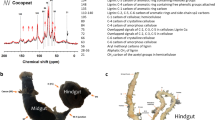Abstract
Larvae of the balsam fir sawyer,Monochamus marmorator Kby. (Coleoptera, Cerambycidae), contain midgut digestive enzymes active against hemicellulose and cellulose. Cellulases from larvae fed on balsam fir wood infected with the fungus,Trichoderma harzianum Rifai (Deuteromycetes, Moniliales, Moniliaceae), were found to be identical to those of the cellulase complex produced by this fungus when compared using chromatography, electrophoresis, and isofocusing. When larvae are maintained on a fungus-free diet, their midgut fluids lack cellulolytic activity, and they are unable to digest cellulose. Cellulolytic capacity can be restored by feeding the larvae wood permeated by fungi. We conclude that the enzymes which enableM. marmorator larvae to digest cellulose are not produced by the larvae. Instead, the larvae acquire the capacity to digest cellulose by ingesting active fungal cellulases while feeding in fungus-infected wood.
Similar content being viewed by others
References
Becker, G. 1942. Untersuchungen über die Ernahrungsphysiologie der Hausbockkäfer-larven.Z. Vergl. Physiol. 29:315–388.
Becker, G. 1968. Einflusz von Ascomyceten und Fungi Imperfecti auf Larven vonHylotrupes bajulus (L.).Mater. Organ. 3:229–240.
Bernfeld, P. 1955. Amylases, α and β, pp. 149–150,in S.P. Colowick and N.O. Kaplan (eds.). Methods in Enzymology, Vol. 1. Academic Press, New York.
Bletchly, J.D. 1953. The influence of decay in timber on susceptibility to attack by the common furniture beetle,Anobium punctatum DeG.Ann. Appl. Biol. 40:218–221.
Bradford, M.M. 1976. A rapid and sensitive method for the quantitation of microgram quantities of protein utilizing the principle of protein-dye binding.Anal. Biochem. 72:248–254.
Buchner, P. 1928. Holznahrung und Symbiose. Springer Verlag, Berlin.
Campbell, W.G. 1929. The chemical aspect of the destruction of oakwood by powder-post and death-watch beetles:Lyctus species andXestobium species.Biochem. J. 23:1290–1293.
Campbell, W.G. 1941. The relationship between nitrogen metabolism and the duration of the larval stage of the death-watch beetle (Xestobium rufovillosum DeG.) reared in wood decayed by fungi.Biochem. J. 35:1200–1208.
Campbell, W.G., andBryant, S.A. 1940. A chemical study of the bearing of decay byPhellinus cryptarum Karst, and other fungi on the destruction of wood by the death-watch beetle (Xestobium rufovillosum DeG.).Biochem. J. 34:1404–1414.
Chararas, C. 1981. Étude du comportement nutritionnel et de la digestion chez certains Cerambycidae xylophages.Mater. Org. 16:207–264.
Chararas, C., Courtois, J.E., Le Fay, A., andThuillier, A. 1971. Biologie, évolution et nutrition dePhoracantha semipunctata, Coléoptère Cerambycidae spécifique desEucalyptus.C.R. Soc. Biol. 165:1565–1568.
Côté, W.A. 1977. Wood ultrastructure in relation to chemical composition.Recent Adv. Phytochem. 11:45–78.
Dajoz, R. 1968. La digestion du bois par les insectes xylophages.Ann. Biol. 7:1–38.
Fisher, R.C. 1940. Studies of the biology of the death-watch beetle,Xestobium rufovillosum DeG.Ann. Appl. Biol. 27:545–557.
Fisher, R.C. 1941. Studies of the biology of the death-watch beetle,Xestobium rufovillosum DeG.Ann. Appl. Biol. 28:244–260.
Kukor, J.J., andMartin, M.M. 1983. Acquisition of digestive enzymes by siricid woodwasps from their fungal symbiont.Science 220:1161–1163.
Leach, J.G., Orr, L.W., andChristensen, C. 1937. The interrelationships of bark beetles and blue-staining fungi in felled Norway pine timber.J. Agric. Res. 49:315–341.
Linsley, E.G. 1959. Ecology of Cerambycidae.Annu. Rev. Entomol. 4:99–138.
Mansour, K., andMansour-Bek, J.J. 1934a. The digestion of wood by insects and the supposed role of microorganisms.Biol. Rev. 9:363–382.
Mansour, K., andMansour-Bek, J.J. 1934b. On the digestion of wood by insects.J. Exp. Biol. 11:243–256.
Martin, M.M. 1983. Cellulose digestion in insects.Comp. Biochem. Physiol. 75A:313–324.
Martin, M.M. 1984. The role of ingested enzymes in the digestive processes of insects, pp. 155–172,in J.M. Anderson, A.D.M. Rayner, and D. Walton (eds.). Animal-Microbial Interactions. Cambridge University Press, Cambridge.
Martin, M.M., andMartin, J.S. 1978. Cellulose digestion in the midgut of the fungus-growing termiteMacrotermes natalensis: The role of acquired digestive enzymes.Science 199:1453–1455.
Martin, M.M., andMartin, J.S. 1979. The distribution and origins of the cellulolytic enzymes of the higher termite,Macrotermes natalensis.Physiol. Zool. 52:11–21.
Martin, M.M., Martin, J.S., Kukor, J.J., andMerritt, R.W. 1980. The digestion of protein and carbohydrate by the stream detritivore,Tipula abdominalis (Diptera: Tipulidae).Oecologia 46:360–364.
Parkin, E.A. 1940. The digestive enzymes of some wood-boring beetle larvae.J. Exp. Biol. 17:364–377.
Piccioni, R., Bellemare, G., andChua, N.H. 1982. Methods of polyacrylamide gel electrophoresis in the analysis and preparation of plant polypeptides, pp. 985–1014,in M. Edelman, R.B. Hallick, and N.H. Chua (eds.). Methods in Chloroplast Molecular Biology. Elsevier, Amsterdam.
Rapson, W.H. 1963. Cellulose from bleached wood pulp, pp. 22–24,in R.L. Whistler (ed.). Methods in Carbohydrate Chemistry, Vol. 3. Academic Press, New York.
Updegraff, D.M. 1969. Semimicro determination of cellulose in biological materials.Anal. Biochem. 32:420–424.
Uvarov, B.P. 1929. Insect nutrition and metabolism.Trans. Entomol. Soc. London 76:255–343.
Author information
Authors and Affiliations
Rights and permissions
About this article
Cite this article
Kukor, J.J., Martin, M.M. Cellulose digestion inMonochamus marmorator Kby. (Coleoptera: Cerambycidae): Role of acquired fungal enzymes. J Chem Ecol 12, 1057–1070 (1986). https://doi.org/10.1007/BF01638996
Received:
Accepted:
Issue Date:
DOI: https://doi.org/10.1007/BF01638996




